News & Updates
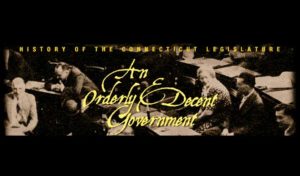
An Orderly & Decent Government: Business and Government, 1905-1929
The early years of the 20th century were a time of vigorous political and social reform.
Read
An Orderly & Decent Government: Making Self-Government Work, 1776-1818
The freedom won in the American Revolution did not spread to African Americans. The Constitution of 1818 formed the basis for state government until 1965.
Read
An Orderly & Decent Government: A Society in Ferment, 1819-1865
Industry, immigration, and urbanization characterized Connecticut in the 19th century.
Read
An Orderly & Decent Government: Making Self-Government Work, 1888-1905
Connecticut’s ancient system of town-based representation ensured the continuation of small town values and perspectives.
Read
An Orderly & Decent Government: Establishing Self Government, 1634-1776
Puritans from Massachusetts settled early Connecticut towns, and in 1639 drew up “The Fundamental Orders” by which they would be governed.
Read
An Orderly & Decent Government: Making Self-Government Work, 1634-1776
In 1698 the General Court reorganized itself to deal more effectively with Connecticut’s complex new problems.
Read
An Orderly & Decent Government: Significant Events & Developments, 1634-1776
After the Pequot War, New settlers and speculators sought to establish new towns from the colony’s undistributed lands.
Read
An Orderly & Decent Government: Searching for the Common Good, 1819-1865
During the early 19th century, the General Assembly was slow to deal with rising crime, poverty and the other social costs of a rapidly changing society.
Read
An Orderly & Decent Government: Searching for the Common Good, 1888-1905
Stimulated by immigration and industrialization, Connecticut cities expanded rapidly
Read
An Orderly & Decent Government: Searching for the Common Good, 1634-1776
In the Great Awakening, impassioned evangelical ministers attracted crowds of thousands and the General Assembly promptly banned traveling preachers.
Read
An Orderly & Decent Government: Significant Events & Developments, 1888-1905
Connecticut saw its population of immigrants from southern and eastern Europe swell in the last decades of the 19th century.
Read
An Orderly & Decent Government: Making Self-Government Work, 1819-1865
In the mid-19th century, Connecticut looked toward changing its electoral processes as well as its civil rights record.
Read
An Orderly & Decent Government: A Clash of Cultures, 1888-1905
In the last decades of the 19th century, Connecticut was transformed by a massive flood of immigrants fleeing political and economic instability.
Read
An Orderly & Decent Government: Making Self-Government Work, 1929-1964
Connecticut attempted to reorganize it state government by streamlining its agencies and rejected a number of socially progressive programs.
Read
An Orderly & Decent Government: Searching for the Common Good, 1905-1929
J. Henry Roraback dominated Connecticut like no political leader before him.
Read
An Orderly & Decent Government: Significant Events & Developments, 1905-1929
Early 20th century life in Connecticut was marked by the election of 1912, US entry into World War I, and the Great Depression.
Read
An Orderly & Decent Government: Significant Events & Developments, 1819-1865
Connecticut in the 1830s was characterized by a move from agriculture to industry, and the loss of residents to westward migration.
Read
An Orderly & Decent Government: Searching for the Common Good, 1776-1818
During the American Revolution, loyalists were common in Connecticut. Those sympathetic to the patriot cause helped provide for the Continental army.
Read
An Orderly & Decent Government: Making Self-Government Work, 1905-1929
With war’s end, suffrage advocates stepped up their campaign for equal rights.
Read
An Orderly & Decent Government: Searching for the Common Good, 1929-1964
Organized labor grew strong during wartime while discriminatory practices in housing and education persisted throughout the state.
Read
An Orderly & Decent Government: Making Self-Government Work, 1866-1887
The late 1800s witnessed significant challenges to Connecticut’s voting and taxation laws.
Read
An Orderly & Decent Government: Significant Events & Developments, 1929-1964
The era of Wilbur Cross and the Great Depression transitioned into World War II and state control by Democrat mastermind John Bailey.
Read
An Orderly & Decent Government: Significant Events & Developments, 1965-Now
Connecticut recast its constitution, reapportioned its House and Senate, and struggled with providing equal rights to all races and socio-economic classes in the state.
Read
An Orderly & Decent Government: Significant Events & Developments, 1776-1818
With its limited supply of fertile land either occupied or exhausted, one of Connecticut’s principal exports in the post-Revolutionary years was people.
Read
An Orderly & Decent Government: A Co-Equal Branch of Government, 1965-Now
Connecticut replaced town-based representation with legislative districts while the state struggled to supply equal opportunities across race and class lines.
Read
An Orderly & Decent Government: Searching for the Common Good, 1866-1887
In 1873, the legislature began to look more closely at the problems of Connecticut’s workers.
Read
An Orderly & Decent Government: Making Self-Government Work, 1965-Now
The 1965 state constitution helped redistribute populations more evenly into districts. It was also a period of new representation for women and African Americans in the state government.
Read
An Orderly & Decent Government: Significant Events & Developments, 1866-1887
After the Civil War, arms manufacturing kept Connecticut industries busy, but an economic depression in the 1870s drastically changed things.
Read
An Orderly & Decent Government: Crisis and Recovery, 1929-1964
World War II helped bring an end to the Great Depression in Connecticut. Following the war, the growth of the suburbs redefined life in the state.
Read
An Orderly & Decent Government: Searching for the Common Good, 1965-Now
The state generated revenue for urban renewal and social programs through gaming and income tax initiatives.
Read
An Orderly & Decent Government: The Rise of the Factory, 1866-1887
In the years following the Civil War, Connecticut’s transformation to an urban, industrial state intensified.
Read
The Portable Typewriting Machine – Today in History: April 12
On April 12, 1892, the first US patent for a truly portable typewriter was issued to George C. Blickensderfer of Stamford.
Read
Civil Rights Demonstrations – Today in History: March 18
On March 18, 1965, about 90 Connecticut residents boarded a plane at Bradley Airport to participate in the Civil Rights protest marches over voter registration rights in Alabama.
Read
Alfred Carlton Gilbert, Inventor of the Erector Set – Today in History: February 15
A. C. Gilbert, a successful Olympic athlete, invented the Erector Set after being inspired by the structures he saw while on a train ride from New Haven to New York in 1911.
Read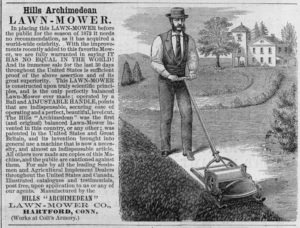
Reel Lawn Mower Patent – Today in History: January 28
On January 28, 1868, Amariah Hills of Hockanum, Connecticut, received the first US patent for a reel-type lawn mower and sold the patent in the 1870s.
Read
Yale University from Colonial Times to the Present
Yale University has grown from the small “Collegiate School” founded in Saybrook in 1701 to one of the most prestigious universities in the world.
Read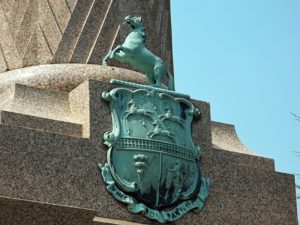
The Colt Memorial, Cedar Hill Cemetery
Commissioned by Samuel Colt’s wife, Elizabeth Jarvis Colt, and James G. Batterson designed the Colt memorial monument in Hartford’s Cedar Hill Cemetery.
Read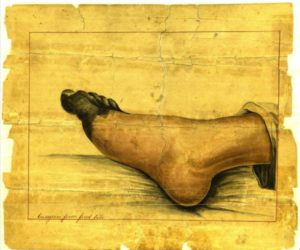
Civil War Soldier Dies of Gangrene – Today in History: July 10
On July 10, 1864, Civil War soldier Curtis Bacon of Simsbury died of gangrene from injuries he suffered in combat nearly two months earlier.
Read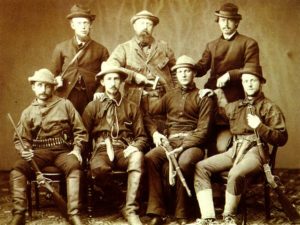
The Who, What, Where, When and Why of Archives: How to Use Them
You could probably guess what archives might be, but think you have never seen one, or have never used one. The truth is most of us have probably used archives and don’t even know it.
Read
Waterford’s Need for Speed
The Waterford Speedbowl is a 3/8-mile oval racetrack located along Route 85 in Waterford, Connecticut.
Read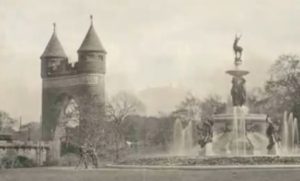
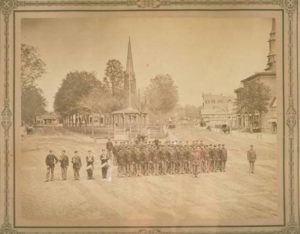
The Civil War Commences: Connecticut’s Involvement in the Civil War
Diaries, letters, and other documents provide firsthand witness to the sacrifices of Connecticut men and women during the years of bloody conflict.
Read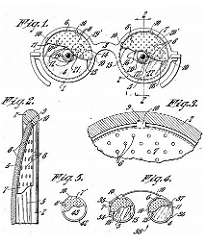
Patents – Stafford’s Inventive Minds
Starting in 1790, Connecticut became a national leader in obtaining patents for its abundant innovations. It not only led the nation in patents issued per capita, but in 1809, South Killingly resident Mary Kies became the first woman awarded a US patent.
Read
Video – Unsung Heroes: The Music of Jazz in New Haven
This documentary clip showcases the heritage of New Haven’s jazz community, weaving the personal narrative of musicians and their families within the context of the city’s social and political history.
Read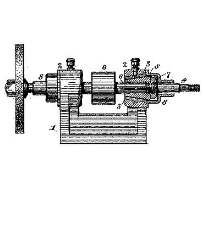
Patents – Bloomfield’s Inventive Minds
From the time the federal government first began issuing patents in 1790, Connecticut was a national leader in patenting its abundant innovations.
Read
Video – Augusta Lewis Troup Tribute Film
The Connecticut Women’s Hall of Fame pays tribute to Augusta Lewis Troup, a pioneering labor leader, journalist, educator, and suffragist.
Read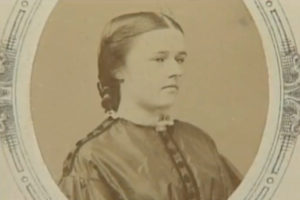
Video – Dotha Bushnell Hillyer Tribute Film
The Connecticut Women’s Hall of Fame pays tribute to philanthropist Dotha Bushnell Hillyer, patron of a living memorial to her father, the Reverend Horace Bushnell.
Read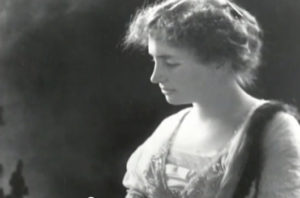
Video – Helen Keller Tribute Film
The Connecticut Women’s Hall of Fame pays tribute to Easton resident Helen Keller, an inspirational champion for the disabled.
Read
Video – Florence Wald Tribute Film
The Connecticut Women’s Hall of Fame pays tribute to Florence Wald, founder of hospice care in the United States.
Read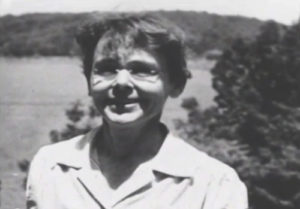
Video – Barbara McClintock Tribute Film
The Connecticut Women’s Hall of Fame pays tribute to Hartford native Barbara McClintock, a famed geneticist and Nobel Prize winner.
ReadMore Articles



